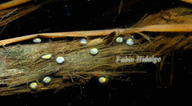|
Description
These moderately large burrowing frogs have a very unique morphology. Their body is flaccid and covered with loose skin. Their snout is shortened both laterally and ventrally and both the snout and vent are covered with sensory tubercles. The head is very tiny and pointed and the eyes are also very small. They have no neck and no visible tympanum. They have short, robust limbs, and their front digits have only a trace of webbing, while the four back digits are short and extensively webbed. They also have two enlarged spades on the inner surface of the metatarsus (ankle). Coloration patterns show scattered loose spots and blotches ranging in color from yellow to reddish orange in varying degrees of shading, the dorsal color is dark brown or nearly black. The males have paired internal vocal sacs. The females tend to be substantially larger than the males in this species (description from Lee 1996).
The tadpoles of Rhynophrynus dorsalis show distinct characteristics. The dorsum of the tadpoles is generally dark gray to black while the venter is iridescent silver. At night, the head and body are often translucent, and Lee,(1996)
suggests that the pigmentation may exhibit a diel cycle. The head is flat and broad with small laterally placed eyes and a slit for a mouth, which is surrounded by delicate barbles. The tail is usually about 1.5 times the length of the body and the dorsal fin extends onto the posterior third of the body. Both the dorsal and ventral fins are of about the same depth (description from Lee 1996).
Distribution and Habitat
Country distribution from AmphibiaWeb's database: Belize, Costa Rica, El Salvador, Guatemala, Honduras, Mexico, Nicaragua, United States U.S. state distribution from AmphibiaWeb's database: Texas
This species occurs at low elevations on the Atlantic slope, from southern Texas to Guatemala, and on the Pacific slope, from Guerrero to Costa Rico. They are generally found on savannas and seasonally dry forest (Lee 1996).
Life History, Abundance, Activity, and Special Behaviors
These terrestrial frogs construct subterranean burrows to make it through the dry seasons without suffering from desiccation. They burrow backwards into the soil, using the enlarged spades on the back of their heels. Their above ground activity is limited to the rainy season when they feed on termites, ants and other insects. The beginning of the rainy season marks the mating season, and males are usually found in large choruses in temporary bodies of water. The female, after inguinal amplexus will release several thousand eggs, either individually or in small groups, into the water. The eggs will sink to the bottom and hatch within a few days (descriptions from Lee 1996).
Comments
Rhynophrynus dorsalis has a very unique call, in fact as Lee (1996)
brings to our attention, the Mayan name for the species, uo, is an onomatopeic rendering of the call. The call has been described as "a loud, protracted, ascending whoop, or uooooooooo, it is also described as being well modulated with a distinct harmonic structure" (Lee 1996)..
The sound is loud and travels great distances. Etymology: Rhinophrynus is from the Greek rhinos, meaning nose and phrynus, meaning toad. dorsalis, comes from Latin, meaning "pertaining to the back" (Lee 1996).
Although commonly referred to as 'toads', Rhynophrynus is not related to the family Bufonidae; this species is the only extant representative of the family Rhynophrynidae (e.g. Ford and Cannatella 1992)
A Spanish-language species account can be found at the website of Instituto Nacional de Biodiversidad (INBio).
References
Ford, L.S., and Cannatella, D.C. (1993). "The major clades of frogs." Herpetological Monographs, 7, 94-117. [link]
Lee, J. C. (1996). The Amphibians and Reptiles of the Yucatan Peninsula. Cornell University Press, Ithaca, New York.
Originally submitted by: Amy Jess, Meredith J. Mahoney (first posted 1999-05-21)
Edited by: Meredith J. Mahoney (2021-04-27)Species Account Citation: AmphibiaWeb 2021 Rhinophrynus dorsalis: Mexican Burrowing Toad <https://amphibiaweb.org/species/4319> University of California, Berkeley, CA, USA. Accessed Jun 1, 2025.
Feedback or comments about this page.
Citation: AmphibiaWeb. 2025. <https://amphibiaweb.org> University of California, Berkeley, CA, USA. Accessed 1 Jun 2025.
AmphibiaWeb's policy on data use.
|





 Map of Life
Map of Life